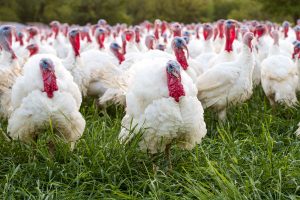
The best part about having a not for profit blog site is the ability to write the whole truth, as I see it. Further, the capability of quickly receiving worldwide review and feedback has the potential of helping me further my meat education. Fowl meat (chicken and turkey) is not my strong suit, but once a year I’m in charge of cooking a whole turkey so I try hard to do a good job of it.
Modern commercially raised turkeys grow big fast; reaching market weights while they are still young and tender. Due to not being fully mature when harvested, such birds are also very lean. Uncastrated tom turkeys grow faster than hens, but unlike in hogs and cattle intact market age male turkeys do not display any objectionable carcass characteristics. It’s the tom turkey’s larger size/weight that pushes their carcasses mainly into fresh ground or further processed precooked poultry products. In turkey further processing thick meat is boned from the carcass then the remaining meat is gleaned from wings, necks, legs and the frame using the MSM (mechanically separated meat) process. To learn more about MSM click here. MSM is used primarily used as a component of emulsion type meat products (wieners & bologna) or in some turkey-hydrated soy taco fillings. Turkey skins, sodium phosphate and other ingredients are often incorporated to add desirable palatability characteristics to turkey end-products. Some toms are offered whole to fill the small demand for heavy turkeys. Since there is a year round market for processed turkey products, most tom meat enters further processing plants as either combos of fresh boneless white or dark meat, or as frozen 40 pound blocks of MSM. The major market for whole turkeys occurs 3 times a year; with Thanksgiving Day being the largest by far. On the combined Holidays of Thanksgiving, Christmas and Easter about 87 million whole turkeys are sold in the U.S. A lot of whole frozen turkey breast are also sold during those times; they are priced to cost as much as the whole bird would have cost (the remainder is further processed). The logistics of having all those raw turkeys on-hand to meet seasonal demands dictates that most of them be freezer stockpiled ahead of time. Like their mainly further processed brothers, young market hens are very lean and it can be challenging for home cooks to prepare them without drying out the white meat. Dark meat has a higher pH level than white meat; which aids in finished product moisture retention. In further processed poultry products sodium phosphate is often used to increase raw meat pH, increase restructured product’s bind and to inhibit fat oxidation. A moderate amount of salt-water brine will enhance moisture retention by way of swelling raw meat proteins. For the reasons mentioned, nearly all (if not all) frozen turkeys are injected with at least a salt containing solution/broth just prior to being flash frozen. Rapidly freezing produces small ice crystals, which in turn causes less rupture of muscle cell walls. Freezing slowly at temperatures closer to meat’s freezing point causes large ice crystal formation that leads to more product purge/weep (increased moisture loss) upon thawing. Other factors involved in a proper freeze job are: oxygen & liquid impermeable tight wrapping, being held continuously below 0F during freezer storage and not being help frozen for too long of a time period. I believe that with proper handling freshly frozen turkeys can yield a more enjoyable eating experience than so-called fresh turkeys. Fresh turkeys appeal to the “designer” crowd that has to have what they perceive is the best of everything. Such consumers are willing to pay more to differentiate themselves from the mainstream. In real-time all poultry has a high incidence of salmonella so carcasses go through a chorine water bath as they exit the kill-floor. As a further intervention, poultry is chilled to 26F. Unenhanced meat begins to freeze at 28F so there are going to be some large ice crystals forming in “fresh” poultry. Most fresh whole chickens are pumped, which lowers the freezing point, but most fresh turkeys aren’t. These factors are likely why injecting and/or brining fresh turkeys is popular. Large ice crystal formation, the method of thawing “fresh” turkeys, the lack of poultry plant brine enhancement and a much higher price per pound are 4 sensible reasons to pass on fresh whole turkeys. Further, today’s commercial turkeys are very uniform (like mainstream market hogs); the major difference between brand names is the color and design of the wrapper.
When it comes time to cook Holiday turkeys some people again invest more time and/or money in the process than is actually required to obtain an optimal eating experience. If your thawed turkey was plant pumped it might become too salty if you home brine or further inject it. I view deep-frying as not being cost effective, not because one might burn down their home, but rather because the deep-fryer unit purchased will likely only see occasional usage and the oil required to fill it cost more then the turkey itself.
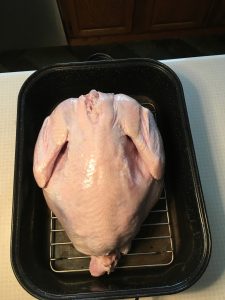
This is my 19 pound it turkey thawed upside-down for 4 days in the bottom of the refrigerator. The hope is that the breast meat will remain saturated with poultry plant injected brine.

Onion, celery and carrot pieces have been stuffed into the body and neck cavities. A cooking rack is being used to keep the breast meat up out of purged cooking liquid (prevents the development of washed-out, water-cooked meat flavor development). The neck was cut in half then pieces placed on both side of the breast to hold the turkey up straight. The roasting pan was then covered and placed in a 325F oven for just over 3 hours. Steam cooking takes at least an hour and a half hour off open roasting pan turkey label chart times.
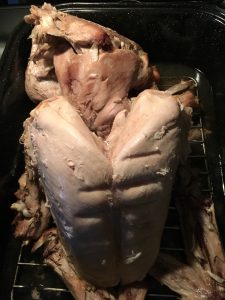
The white meat in the wings was a little dry, the rest of the bird ate great: vegetable and meat juices gravity-fed to the breast meat throughout the cook. This cooking method does not produce the best looking cooked turkey, but it is easy to skin and carve.
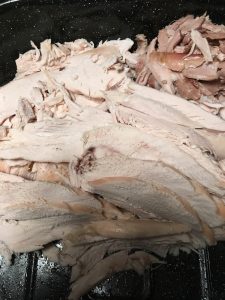
Fairly inexpensive: (54 cents a pound with the additional purchase of $20 in groceries), very easy to cook and very delicious. I have been cooking whole turkeys using this method for about 25 years and have never been disappointed.
Add on:
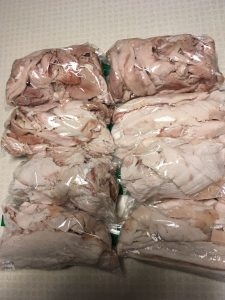
I bought this pictured name brand frozen turkey the Sunday after Thanksgiving at 48 cents per pound; then put the precooked meat up in freezer storage.
